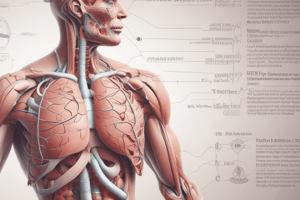Podcast
Questions and Answers
What is the primary function of the upper respiratory tract?
What is the primary function of the upper respiratory tract?
- To serve as an entry point for air (correct)
- To regulate pH levels
- To transport oxygen to the body's cells
- To facilitate gas exchange
During exhalation, what happens to the diaphragm?
During exhalation, what happens to the diaphragm?
- It remains unchanged
- It contracts and flattens
- It relaxes and rises (correct)
- It expands and moves upward
Where does gas exchange occur in the respiratory system?
Where does gas exchange occur in the respiratory system?
- In the alveoli (correct)
- In the trachea
- In the pharynx
- In the bronchi
What is the role of the bronchioles in the respiratory system?
What is the role of the bronchioles in the respiratory system?
What is the primary function of the respiratory system in terms of pH regulation?
What is the primary function of the respiratory system in terms of pH regulation?
What happens to oxygen in the alveoli?
What happens to oxygen in the alveoli?
Flashcards are hidden until you start studying
Study Notes
Functions of the Respiratory System
- Brings oxygen into the body
- Removes carbon dioxide from the body
- Regulates pH levels by removing excess hydrogen ions
Components of the Respiratory System
- Upper Respiratory Tract
- Nose and mouth (entry points for air)
- Pharynx (throat)
- Larynx (voice box)
- Lower Respiratory Tract
- Trachea (windpipe)
- Bronchi (tubes that branch off from trachea)
- Bronchioles (smaller tubes that branch off from bronchi)
- Alveoli (tiny air sacs where gas exchange occurs)
Mechanism of Breathing
- Inhalation
- Diaphragm contracts and flattens
- Rib cage expands and moves upward
- Air enters through mouth or nose
- Air passes through trachea and bronchi
- Air enters alveoli
- Exhalation
- Diaphragm relaxes and rises
- Rib cage descends and moves downward
- Air leaves alveoli
- Air passes through bronchi and trachea
- Air exits through mouth or nose
Gas Exchange
- Oxygen
- Enters alveoli through inhalation
- Diffuses into capillaries surrounding alveoli
- Binds to hemoglobin in red blood cells
- Transports to cells throughout the body
- Carbon Dioxide
- Produced by cells throughout the body
- Transports to lungs through bloodstream
- Diffuses out of capillaries and into alveoli
- Exhales out of the body through exhalation
Respiratory System Functions
- Brings oxygen into the body for cellular respiration
- Removes carbon dioxide, a waste product, from the body
- Regulates pH levels by removing excess hydrogen ions to maintain acid-base balance
Respiratory System Components
- Upper Respiratory Tract
- Nose and mouth serve as entry points for air
- Pharynx (throat) connects nose and mouth to the lungs
- Larynx (voice box) contains vocal cords for sound production
- Lower Respiratory Tract
- Trachea (windpipe) divides into bronchi
- Bronchi branch into bronchioles, which lead to alveoli
- Alveoli are tiny air sacs where gas exchange occurs between air and blood
Breathing Mechanism
- Inhalation
- Diaphragm contracts and flattens, increasing chest cavity volume
- Rib cage expands and moves upward, further increasing chest cavity volume
- Air enters through the mouth or nose, passes through the trachea, and bronchi
- Air reaches the alveoli, where oxygen is absorbed and carbon dioxide is removed
- Exhalation
- Diaphragm relaxes and rises, decreasing chest cavity volume
- Rib cage descends and moves downward, further decreasing chest cavity volume
- Air leaves the alveoli, passes through the bronchi and trachea, and exits through the mouth or nose
Gas Exchange Process
- Oxygen
- Enters alveoli through inhalation
- Diffuses into capillaries surrounding alveoli, where it binds to hemoglobin in red blood cells
- Transports to cells throughout the body for cellular respiration
- Carbon Dioxide
- Produced by cells throughout the body as a waste product
- Transports to the lungs through the bloodstream
- Diffuses out of capillaries and into alveoli, where it is exhaled out of the body
Studying That Suits You
Use AI to generate personalized quizzes and flashcards to suit your learning preferences.



